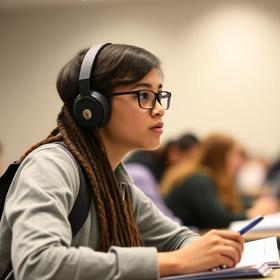- The mission of Eastern Arizona College is to provide open access to quality higher education primarily to residents of its service area. The College is accountable to its students and to the community for educational results, fiscal responsibility, and cooperation in community affairs.
School Highlights
Eastern Arizona College serves 7,084 students (24% of students are full-time).
The college's student-teacher ratio of 18:1 is lower than the state community college average of 22:1.
Minority enrollment is 36% of the student body (majority Hispanic), which is less than the state average of 61%.
Quick Facts (2025-26)
- Enrollment: 7,084 students
- In-state tuition: $2,000
- Out-state tuition: $9,200
- Acceptance Rate: 75%
- Student-teacher ratio: 18:1
- Minority enrollment: 36%
- Source: Integrated Postsecondary Education Data System (IPEDS)
Top Rankings
Eastern Arizona College ranks among the top 20% of public schools in Arizona for:
Category
Attribute
Selectivity
School Overview
The teacher population of 400 teachers has stayed relatively flat over five years.
Eastern Arizona College
(AZ) Community College Avg.
Carnegie Classification
Associate's Colleges: Mixed Transfer/Career & Technical-High Nontraditional
Baccalaureate/Associate's Colleges: Mixed Baccalaureate/Associate's
Institution Level
At least 2 but less than 4 years
At least 2 but less than 4 years
Institution Control
Public
Public
Colors
Purple, Gold
Total Faculty
400 staff
202 staff
School Calendar
Student Body
The student population of Eastern Arizona College has grown by 17% over five years.
The student-teacher ratio of 18:1 has increased from 11:1 over five years.
The Eastern Arizona College diversity score of 0.53 is less than the state average of 0.71. The school's diversity has stayed relatively flat over five years.
Total Enrollment
7,084 students
5,392 students
Student-Teacher Ratio
18:1
22:1
# Full-Time Students
1,684 students
1,208 students
# Part-Time Students
5,400 students
4,184 students
# Enrollment Undergraduate
708 students
339 students
# Full-Time Undergraduate Students
1,684 students
1,238 students
# Full-Time Graduate Students
n/a
66 students
# Part-Time Undergraduate Students
5,400 students
5,400 students
# Part-Time Graduate Students
n/a
11 students
Total Dormitory Capacity
370 students
250 students
% American Indian/Alaskan
5%
3%
% Asian
1%
4%
% Hispanic
23%
36%
% Black
1%
7%
% White
64%
39%
% Hawaiian
n/a
2%
% Two or more races
1%
4%
% Non Resident races
1%
1%
% Unknown races
3%
4%
Diversity Score
0.53
0.71
College Completion Rate (Students who graduate in less than 4 years)
49%
49%
College Completion Rate (Students who graduate in 4 years or more than 4 years)
n/a
60%
Average Graduate Earnings (10 Years)
$33,800
$32,900
Tuition and Acceptance Rate
The public in-state tuition of $2,000 is less than the state average of $3,445. The in-state tuition has declined by 25% over four years.
The public out-state tuition of $9,200 is more than the state average of $8,201. The out-state tuition has stayed relatively flat over four years.
In-State Tuition Fees
$2,000
$3,445
Out-State Tuition Fees
$9,200
$8,201
% Students Receiving Some Financial Aid
82%
82%
Median Debt for Graduates
n/a
$9,500
Median Debt for Dropouts
n/a
$4,750
Acceptance Rate
75%
100%
Source: 2024 (or latest year available) Integrated Postsecondary Education Data System (IPEDS) , School Administrators
School Notes
- School Mascot: Fighting Gila Monster
- Eastern Arizona College truly must be experienced in person to fully appreciate its unique character. Our small size, pastoral setting, and diverse student body create an atmosphere unlike anyplace else you will find in Arizona. In fact, at first glimpse of the campus, lined with sycamores and evergreens and framed by the Gila and Pinaleno Mountains, you'll feel this is a place you can call home. Eastern Arizona is a public community college. Founded as St. Joseph Stake Academy in 1888, it provided education for the youth of the Gila Valley from 1890 until 1933. The institution introduced junior college courses in the early 1920s. Eastern Arizona College is accredited by The Higher Learning Commission and is a member of the North Central Association. Eastern Arizona College has a comprehensive financial aid program to ensure, to the extent of available funding, that no student will be denied a college education because of lack of funds. EAC believes that primary responsibility for financing your education rests with you and your family. The ability of you and your family to provide that support is calculated through a federally approved needs analysis system. Eastern Arizona College encourages and supports a varied program of student activities and organizations. These include athletics, dramatics, music, religion, student publications, intramural sports, politics, and social and scholastic organizations.
Frequently Asked Questions
How much does Eastern Arizona College cost?
Eastern Arizona College's tuition is approximately $2,000 for In-State students and $9,200 for Out-State students.
What is the acceptance rate of Eastern Arizona College?
The acceptance rate of Eastern Arizona College is 75%, which is lower than the state average of 100%. Eastern Arizona College's acceptance rate is ranked among the top community colleges in Arizona with low acceptance rates.
What is Eastern Arizona College's ranking?
Eastern Arizona College ranks among the top 20% of community college in Arizona for: Lowest acceptance rates.
Recent Articles

Student Success Programs That Actually Work at Community Colleges
Discover evidence-based student success programs at community colleges for 2025, with outcomes, examples, and actionable strategies.

Best Community Colleges by Career Path in 2025
Explore top community colleges for career-training programs in 2025, including healthcare, IT, skilled trades and business pathways.

Dual Enrollment in High School: Benefits, Risks & Real Student Results
Explore the pros and cons of dual enrollment in high school, real outcomes for students in 2025, and how to decide if it’s right for you.









